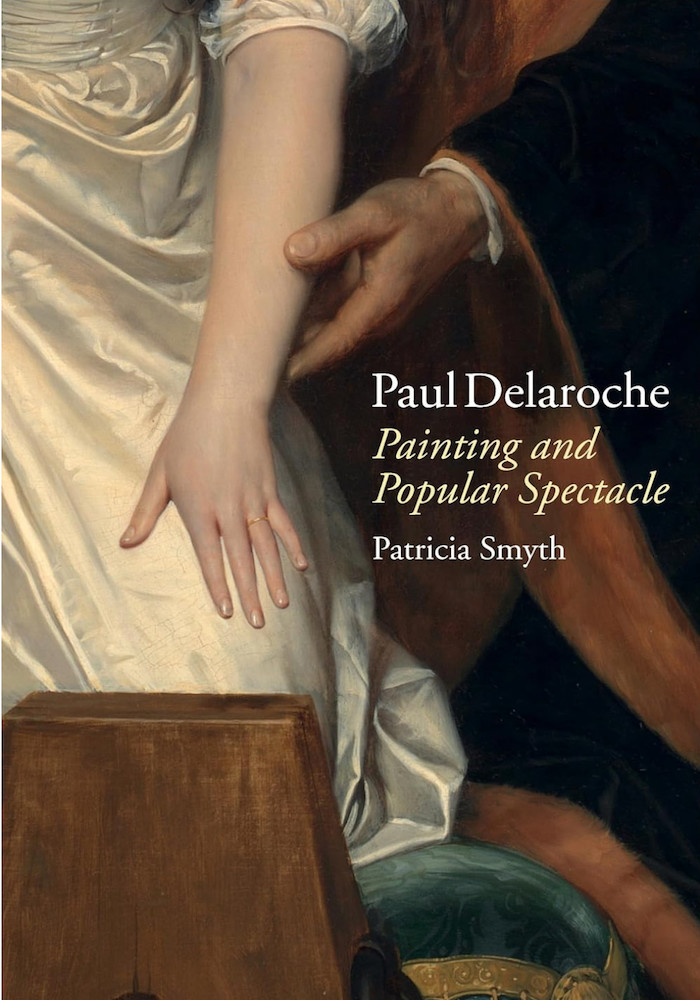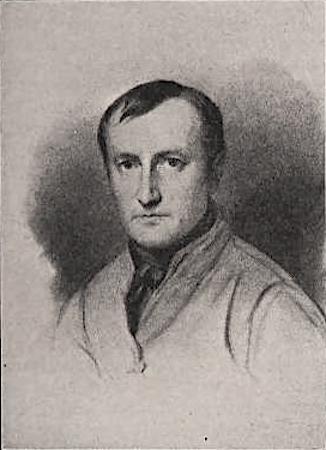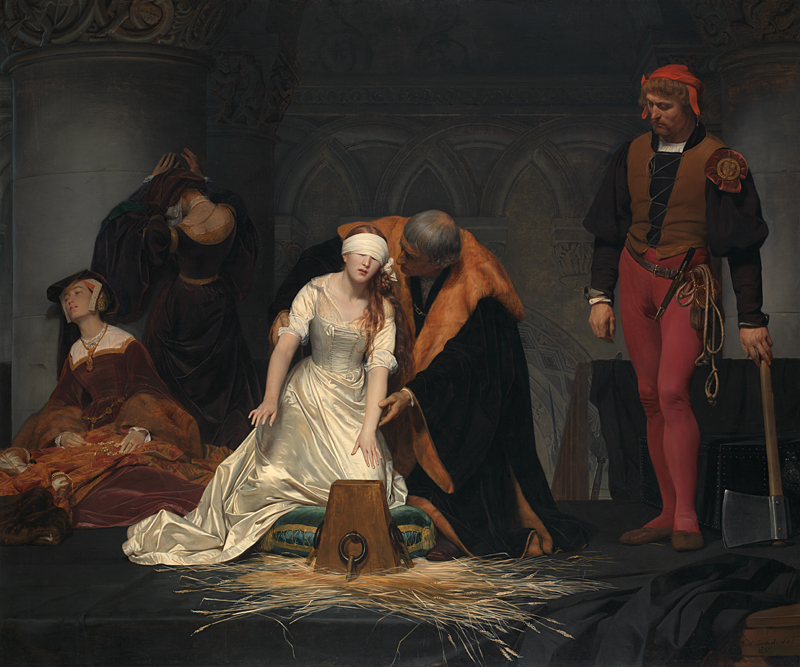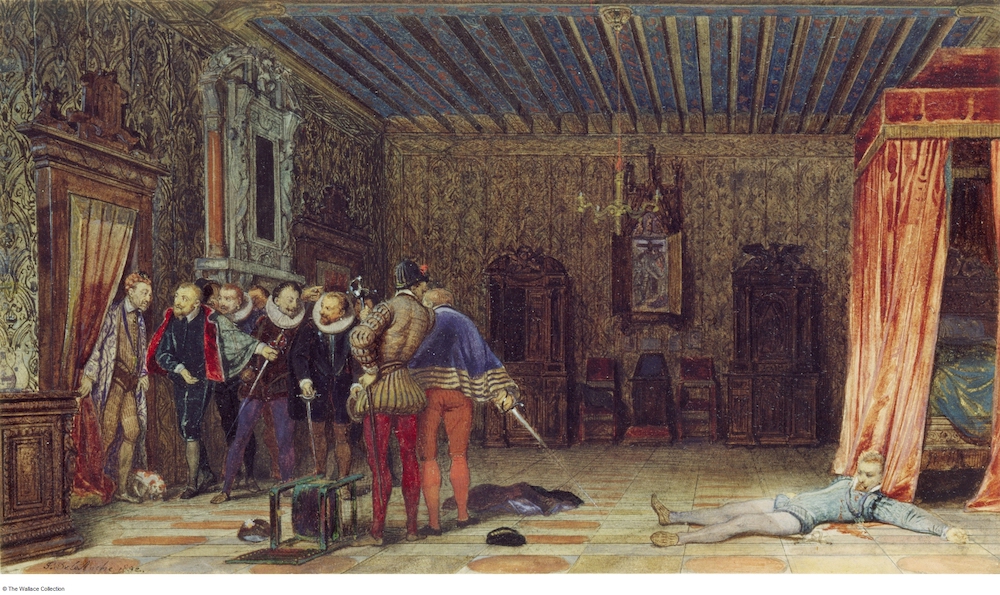
Obviously, Paul Delaroche was a French artist. And as he stopped submitting his works to the Paris Salon after 1837, he was mainly a pre-Victorian painter. But his most famous work remains The Execution of Lady Jane Grey, now one of the icons of the National Gallery (where it had remained in storage for decades when it was somewhat tentatively rehung in 1975, as a contemptible example of a kind of art that had once been successful). Various episodes of the history of England were the inspiration for the most admired paintings he exhibited in the 1820s and 1830s, like The Princes in the Tower – even though one has to go as far as to Nîmes to see his Cromwell and Charles I, while The Death of Queen Elizabeth in 1603 (1827) enjoys the unfortunate honour of being displayed in the Salle Denon in the Louvre, in the worst possible conditions, above a door, under a window, some twenty feet above ground. The rediscovery of Delaroche in recent times was made possible by English-speaking art historians, and his legacy as a history painter clearly had an influence on British artists in the second half of the 19th century – would Leighton have painted Cimabue's Procession if he had not seen Delaroche's Artist of All Ages in the "Hémicycle" of the Ecole des Beaux-Arts? Besides, a work like The Assassination of the Duc de Guise was long considered a prime example of "literary painting," which may be equated with what Henry James called "the importunately narrative quality of the usual English picture" when he visited the Royal Academy in 1877. For all these reasons, it seems legitimate to welcome Delaroche in the Victorian Web.

Portrait of Delaroche in the Catholic Encyclopedia, Vo.IV, p.691.
One of the aims of Patricia Smyth's stimulating book is precisely to demonstrate that Delaroche was not a merely literary painter, and that he did not limit the appreciation of art to an emotional engagement with the scene represented in the most "transparent," illusionistic manner. As Victorian aesthetes would reproach him with the very legibility of his works, enjoyed by the general public the way they enjoyed reading a novel, Smyth reminds us that in his time, Delaroche's works were not always considered easily readable. Far from being a conservative (which he was neither politically nor artistically), Delaroche may even have been a radical in the way he adapted history painting to his ambitions. And illusionism as a form of art is all except transparent, it is the result of deliberately used processes: the illusion of "immediacy" (the direct access to the content, as if there were no form) was cultivated by a modernity which privileged "hypermediacy" (the appreciation of form for its own sake).
The first chapter explains that illusionism is neither neutral nor naive, it is not a case of simple mimesis, but "a sophisticated response to the needs of modern spectators" (26). In the eighteenth century, when looking at Chardin's still lives, Diderot could enjoy both the illusion and the artifice successively; the two were later separated, as if cultivated viewers focused exclusively on elements like brushwork and composition, while the ordinary visitors of the Salon could only take "pleasure in the apparent absence of medium" (32). Just as today's Artificial Intelligence allows its users to forget the technology needed to create the illusion of virtual reality, painterly illusionism was "a medium whose purpose is to disappear," a phrase coined by Jay David Bolter and Richard Grusin in their book Remediation: Understanding New Media (Cambridge, 1999) which is used to great profit by Smyth.
As may now too easily be overlooked, Delaroche chose to transgress the accepted rules of history painting. According to the inherited conception of the grand genre, superfluous details had to be eliminated from such works, because they could detract attention from the central action. Rather than a faithfully realistic representation of events, they should offer convey clear ideas to the mind of the viewer by offering "the unequivocal and properly clarified appearance of reality" ("l'apparence non équivoque et bien débrouillée de la vérité," Paillot de Montabert, Traité complet de la peinture, 1829, as translated by Smyth). For his contemporaries, Delaroche treated historical subjects as if they belonged to genre painting, with a profusion of anecdotal elements, refusing to idealize the scene and its protagonists. A bit like Ruskin's later suggestion that painters should "reject nothing, select nothing, scorn nothing" when in front of nature, Delaroche gave the impression that he had rejected nothing from a reality which he had in fact carefully imagined. While Ingres overemphasized the importance of drawing in his Martyrdom of Saint Symphorian (exhibited the same year as Lady Jane Grey) and thus failed to cause an emotional response in the viewer, Delaroche offered a vision which was neither idealized nor clarified, and his decision to disappear behind his subject made it easier for the viewer to access the human drama.
However, as shown in Chapter 2, the effectiveness of The Execution of Lady Jane Grey also came from the fact that it disappointed traditional expectations. In a time when the representation of passions was still governed by the codification of expressions by Le Brun in the seventeeth century, Delaroche's work offered very little from the point of view of expressive faces. His strategy was one of "creative transgression of the rules" (88). In 1837, Théophile Gautier joked that in Jane Grey not even one eye was truly in evidence, as the heroine was blindfolded and the other characters turned their heads away from the spectator. In Cromwell and Charles I, the mix of emotions on Cromwell's face was judged ambiguous, unclear, hence authentic. From that point of view, there was nothing "theatrical" in Delaroche's art (on the contrary, over-emphatic gesticulation was the accusation leveled at Ingres' Saint Symphorian). In contrast to the classical, "eloquent" mode of diction, Romantic melodrama, with which his paintings were later negatively equated, actually favoured a more natural kind of acting, in which inner passion was judged superior to detached mastery, as opposed to what Diderot had decreed in his Paradoxe sur le comédien, posthumously published in 1830.

The Execution of Lady Jane Grey, by Paul Delaroche, 1833, at the National Gallery. [Click on the image for more details.]
Smyth devotes Chapter 3 to The Assassination of the Duc de Guise, "arguably the most radical rejection of history painting conventions" (114). Delaroche did not represent the event itself, but its disorderly aftermath, "as if we had arrived too late" (119), an anticlimax, apparently without any edifying comment or legible intention. Devoid of the usual range of psychological responses among the supporting characters, it is a "scene of unenlightening self-interest" (119), the result of "a strategy of 'anti-composition'" (124). The Assassination, depicted with all the accurate details expected from genre painting but without its harmonious arrangements, created the illusion of unmediated experience, the viewer witnessing the scene as it could have seen on a stage, or read in a chronicle rather than a moralising history book. And yet, Delaroche did present Guise as a sort of Christian martyr, introducing a hidden meaning behind the apparent insignificance of his work.

The Assassination of the duc de Guise, by Paul Delaroche, 1832 watercolour version of the later (1834) at the Wallace Collection, London. [Click on the image for more details.]
Chapter 4 also reclaims Delaroche for modernity, by including him in "a new kind of popular technologically innovative visual culture" (151) through the notion of remediation. According to Bolter and Grusin's concept, the revision of previous images aims at greater immediacy (the viewer feels even more directly involved in the experience), a better mimesis, the source being acknowledged as "an imperfect and outdated stereotype in need of 'correction'" (158). Delaroche may well have used eighteenth-century English prints as models, but he decided to show the authentic self of historical characters rather than their public persona, i.e. Jane Grey not as the stoic heroine of her own legend but as a human being in a moment of frailty. This new kind of history painting would be imitated all through the second half of the century, by Delaroche's own pupils (Gérôme in his Death of Caesar and especially his Execution of Marshal Ney), but also Waterhouse in his Saint Eulalia.
In her conclusion, Smyth reminds the reader that modernity was born at the beginning of the nineteenth century: while immediacy remains an alluring illusion nowadays, hypermediacy already existed before the invention of photography which made it all the more necessary for painters to distinguish their art from the apparently unmediated quality of "sun-pictures."
Link to Related Material
Bibliography
[Book under review] Smyth, Patricia. Paul Delaroche: Painting and Popular Spectacle. Liverpool: Liverpool University Press, 2022 (hardback edition 2022). 234 pp., 10 colour plates, 51 black and white illustrations. 978-1-80207-021-7. £104.50.
[Illustration source] The Catholic Encyclopedia. Vol IV. New York: Appleton, 1908 (entry written by Louis Gillet). Internet Archive. Web. 4 March 2024.
Created 3 March 2024